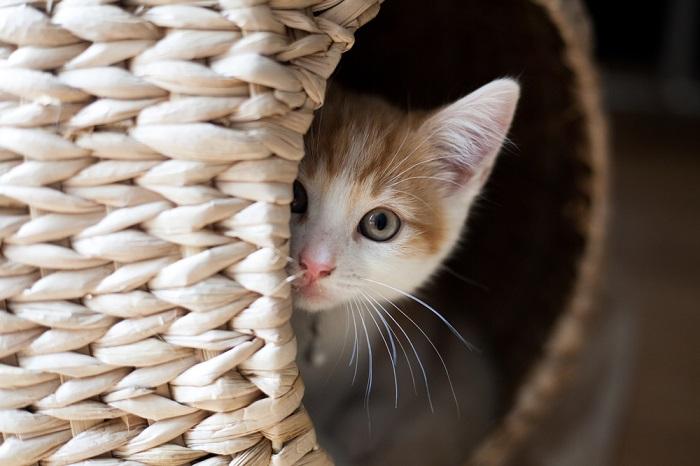Bringing home a new cat is exciting, whether you’re becoming a pet parent for the first time or you already have a cat or two (or three). But even if you’re looking forward to welcoming your new addition, it’s normal to have worries or feel a little stressed about it.
It can take cats several days, weeks, or even months to fully settle in to a new home. Try to keep your new cat's food, litter, and bed setup the same as in their previous home, and introduce them to other pets slowly. If you don’t think that your cat is settling into your home as they should, speak to your veterinarian or a qualified veterinary behaviorist.Key Takeaways
As pet parents we want our fur babies to feel contented. Thankfully, we’ve put together an article with everything you need to know to help make sure the transition is as smooth as possible.
How Do You Make a New Cat Feel at Home?
You might think that adopting or buying a cat or kitten and bringing them home is pretty simple—you just need a food and water bowl, a litter tray or two, some cat food, a cat bed, and the phone number of your local veterinary clinic.
However, ticking off a checklist of the items your cat needs won’t necessarily ensure a smooth transition into your home. It’s not too surprising. If you were placed in a new house with people you had never met before, it wouldn’t necessarily matter that you had some plates, food, a bed, and a bathroom. You would probably still feel unsettled because it wasn’t your home or what you were used to. So, how do you make a new cat feel at home? Let’s find out.
1. Prepare
Of course, having everything that you need ready to welcome your new feline family member is still important. You’ll need to decide where your new cat is going to eat, drink, sleep, and play, as well as the best place to put their litter box.
You’ll also have to stock up on the cat-related equipment and paraphernalia that you need, including food and water bowls, cat litter, litter boxes, a cat bed or blanket, a scratching post or cat tree, and plenty of toys. Knowing that you have everything that you need will help you feel more relaxed, which will mean less anxious vibes for your cat to pick up on. If you need help with what to buy for your new cat, check out our New Cat Owner Checklist.
2. Use Feline Pheromones or Calming Products
When it comes to reducing your new cat’s anxiety and helping them settle into a new environment, pheromones and calming sprays are your friends! From plug-in diffusers to handheld sprays, there are options to suit every home.
Just remember to plug them in or spray them 24 hours before your new family member arrives, to make sure the product has had a chance to circulate. If you are not sure which product to use, speak to your veterinarian or read Best Calming Aid for Cats.
3. Avoid Strong Scents or Cleaning Products
Keep your home’s smells neutral by avoiding harsh cleaning products, scented candles, and potpourri.
Cats have an excellent sense of smell, which means they’re really sensitive to fragrances, even if they don’t seem overpowering to us. If you want your new cat to settle in, skip the incense, reed diffusers, and other home scents. This is especially important with essential oils since they could be toxic or cause irritation to cats.
It’s not just perfumes and home scents that could offend your new cat though, cleaning products can also be heavily scented. So, if you were planning on giving your home a deep clean before welcoming your new cat, try using unscented or mild products instead.
4. Change as Little as Possible
Any information you can gather about your cat or kitten’s current routine will help you to get them settled into your home more quickly. Find out what cat litter and litter box setup they were used to, what type and brand of food they were eating, and other information about their daily routine, then try to replicate as much as you can in your home.
This means using the same treats and cat food, if possible, and using a water bowl or water fountain depending on what they are used to. If they’re used to sleeping on a specific cat bed, try to source a similar style, or ask the previous owner, breeder, or rescue center whether you could take their bed or other favorite items.
If you are able, providing a t-shirt or other item of fabric that smells of you or your home that can be placed with your new cat or kitten for a couple of weeks before the rehoming date could help familiarize them with your scent, ensuring they feel more at ease when it’s time for you to bring them home.
5. Do Introductions Slowly
If you have other pets, especially other cats, it’s important that you introduce them slowly and in a controlled way. Just as you can provide an item with your scent to the breeder, rescue center, or current owner of the cat, if you have other cats, you could provide their scent, too.
However, if you have a large number of cats, this is not a good idea as the sudden arrival of so many different scents would likely be overwhelming.
Once your cat arrives at your home, it’s a good idea to separate them from any other pets initially, so they have their own space to get used to their surroundings. You can then gradually add the scents of the other pets into the room and introduce the new cat’s scent to your existing pets.
Once all pets seem settled and comfortable with the new scents, you can try allowing your new cat and existing pets to see each other. This should be done one at a time, to avoid the new cat feeling vulnerable, and you should ensure that they can only see each other, not make contact.
At any point, if either cat hisses, growls, shows other negative behaviors, or seems anxious, you can close the door again and try again later or the following day.
Once your cats are comfortable in each other’s company, without contact, you can allow them to approach each other. Again, if either cat shows negative body language or becomes aggressive separate them and give them longer to adjust before trying again.
6. Give Them Their Own Safe Space
A huge factor in how quickly your cat settles into your home is whether they have their own safe space to hide if they feel insecure or anxious. This should be somewhere quiet, away from the hustle and bustle of the home.
This could be a crate covered with blankets, a cat hide, an igloo bed, or anything else that shelters them and makes them feel safe. If you have a calming spray, it’s a good idea to spray the blankets or any fabrics within the hide so that they associate it with feeling calm.
7. Be Patient
It might take several days, weeks, or even months until your cat has fully settled in.
It’s totally understandable to be excited about bringing home a new cat. Young children especially are likely to be in a rush to get them out of their box and give them a cuddle. However, it’s important to be patient and give them the time and space that they need to settle.
Many cats don’t feel comfortable enough to even leave their box for an hour or so, and you might find that over the first few days, you barely see your new cat—you just drop food and water off and leave! That’s OK. Don’t rush them. The more space you give them the less anxious they will feel.
8. Use Positive Reinforcement
Using treats as a reward each time your cat makes some progress is a great way to help them settle in. You could try sitting in the room with them quietly and putting some treats at the door of their box. If they come out to eat them and end up tentatively exploring, you could offer a couple more. Move slowly though, especially if they seem shy or nervous.
What if Your New Cat Isn’t Settling In?
Some cats need extra help settling in—your veterinarian can offer plenty of expert advice.
So, what if it’s been a couple of weeks and your cat isn’t making much progress at settling in? Perhaps they can’t tolerate your other cat, run away when you enter the room, or spend most of their time hiding in the wardrobe. What should you do?
1. Give Them Time
Every cat is different, and while some enjoy the company of other cats, they’re usually solitary and independent. Although you might feel a bit impatient, it’s often normal for new cats to take some time to feel settled with other pets and to start being affectionate with their new pet parents. If they’re eating, drinking, passing urine and feces, and moving around OK, they probably just need a little more time.
2. Speak to Veterinarian
If your cat has made no real progress or has seemed to improve but has gone back into hiding, if they’re not eating, drinking, or using their litter tray, or if you notice symptoms of being unwell, it’s really important to make an appointment to get them checked over by a veterinarian, just in case they’re not well.
3. Speak to a Qualified Veterinary Behaviorist
If your cat isn’t settling in as you expected, they’re showing signs of stress, or things just don’t seem quite right, you can speak to a veterinary behaviorist as well as a veterinarian. They will be able to give more advice as to how to help your new cat feel more at ease.
Final Thoughts
Once cats feel at home, they will be comfortable enough to let their true personality shine.
Bringing a new cat or kitten home is exciting, but a bumpy transition into your home could create longer-term behavior problems. So, follow the steps above to help ensure that your new cat feels like a contented member of the family as soon as possible.
Also Read: How To Tell Which Cat Is Dominant
Frequently Asked Questions
How long does it take for a cat to get used to a new home?
All cats are different. Some more confident cats will need only a day or two to adjust, while others will take a couple of weeks or more. It’s likely to be longer if you have other pets or young children, as there’s more to get used to in terms of noises and smells.
How do I make my new cat feel welcome?
To make your new cat feel welcome, try to keep their food, cat litter, and bed set up the same as in their previous home. Try to provide them with an item of clothing with your scent in advance, so they can get familiar with it, and speak to your veterinarian or a qualified behaviorist if you have any concerns.
Where should a cat sleep on the first night?
When you bring a new cat home, you should provide them with their own space. Ideally, this would be a room with their food, water, scratch post, toys, and a cat bed. While it might seem kind to let them sleep on your bed, they’re likely to feel less anxious in their own room.












